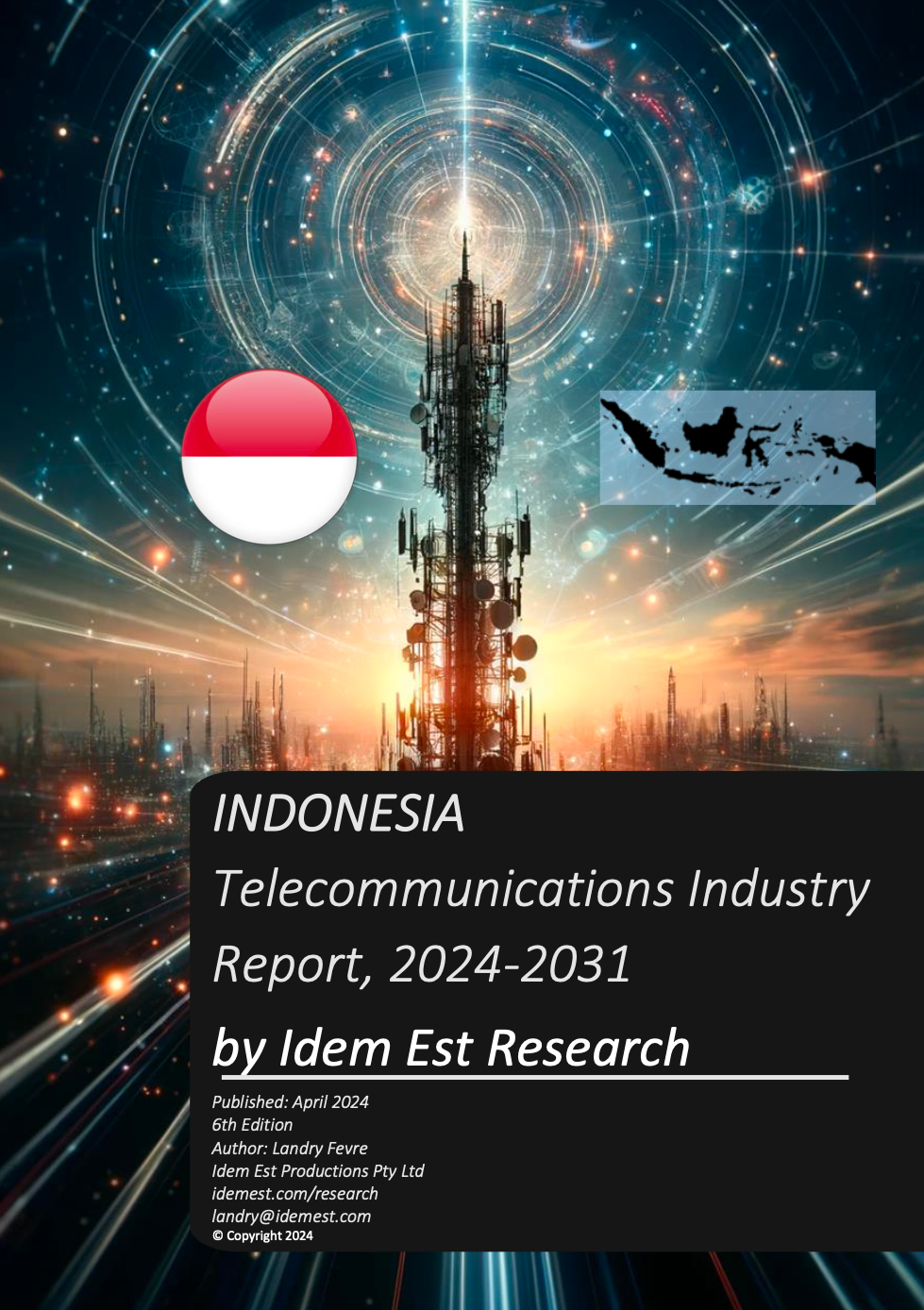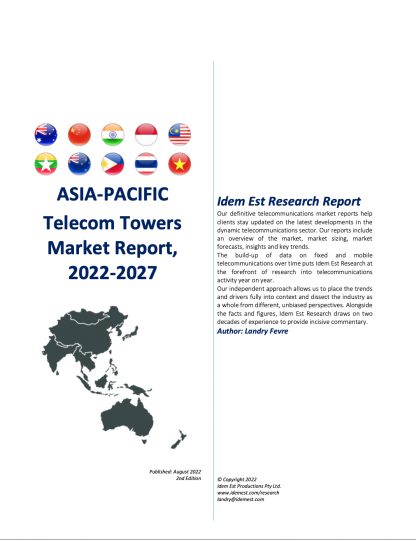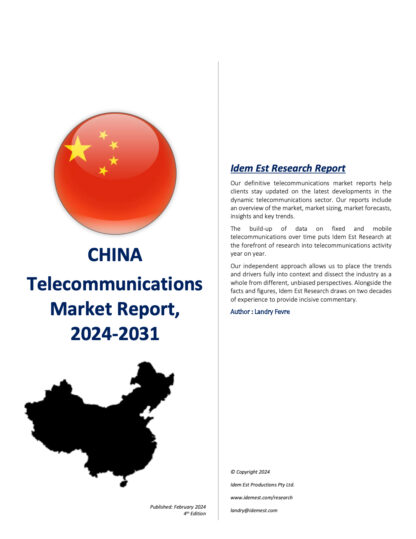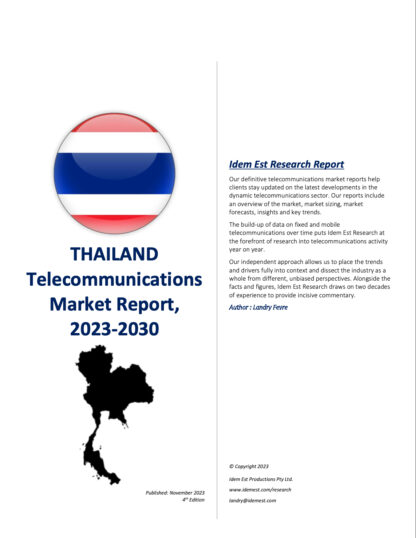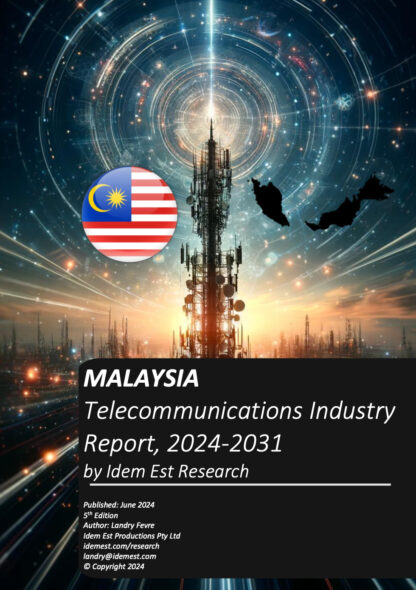Your cart is currently empty!
Indonesia Telecoms Industry Report – 2024-2031
This report provides analyses of revenue and market forecasts as well as statistics of the Indonesian telecoms industry including market sizing, 5-year forecasts, market insights, key telecom trends, 5G, digital infrastructure and also features the following: Overall Telecommunications Market by Major Operators Telco Operators Profile, Revenue and EBITDA Mix Mobile Subscribers & Revenue Market Overview and Forecasts Spectrum Holdings IoT Market Overview Broadband Subscribers & Revenue Market Overview and Forecasts Digital Infrastructure (Fibre, Telecom Towers, Data Centres, Submarine Cables) Telecom Tower Market Analysis and Forecast Thematics / Opportunities relating to 5G, M&A and e-Commerce Telco M&A Transaction Database About this…
Description
WHY YOU SHOULD BUY THIS INDONESIA TELECOMS INDUSTRY REPORT:
- Benefit from the latest market opportunities
- Understand the threats to your operations and investments and protect your company against future risks
- Gain insight on emerging trends that could support, strengthen or disrupt your activities in the market
- Get a full view of the competitive landscape to assess your market position.
- Forecasts as a key input for successful budgeting and strategic business planning in the telecoms market
- Target business opportunities and risks in the telecoms sector through our reviews of latest industry trends, regulatory changes and major deals, projects and investments
- Assess the activities, strategy and market position of your competitors, partners and clients via our Operators Profiles
The Indonesia Telecommunications Industry Report, 2023-2030 includes an overview of the Indonesian market dynamics, market sizing, market forecasts, analysis, insights and key trends.
EXECUTIVE SUMMARY
Indonesia Telecoms Industry Report: Key Developments, Growth Prospects, and Investment Opportunities
Welcome to the Indonesia Telecoms Industry Report, a comprehensive overview of one of the world’s fastest-growing telecommunications markets. As data infrastructure becomes increasingly critical in our connected world, the telecom sector plays a vital role in national economies, attracting large infrastructure funds and driving economic growth. Despite political uncertainties and the inflationary pressure’s economic impact, the Indonesian telecommunications industry is expected to remain steady due to its defensive nature.
Key Developments Covered in the Indonesia Telecoms Industry Report:
- Merger of Indosat and Tri Indonesia
- Acquisition of Link Net by XL Axiata
- Consolidation of towecos
- Launch of 5G services
- FTTH investments drive strong growth in consumer fixed broadband services
According to Idem Est Research, 5G mobile subscribers are projected to represent 78% of all subscriptions in Indonesia by 2031. By 2031, the Indonesian market is projected to have nearly 300 million 5G subscribers.
The report forecasts the total Indonesia telecom market to grow at an average annual rate of 3% from 2024-2031, reaching USD 22.1 billion by 2031. This moderate growth comes despite significant economic and political headwinds facing the country.
The Indonesian telecommunications market thrives as a mobile-centric industry, featuring four large network operators and a dominant fixed-line provider with a near-monopoly. Strong economic fundamentals underpin the overall market, positioning Indonesia as one of the fastest-growing telecom markets globally. The growth is driven by both mobile and fixed broadband subscriptions, with Idem Est Research forecasting continued strong growth in mobile subscriptions from 2024 to 2031, following a temporary slowdown in 2018. Fixed broadband subscribers will also experience sustained growth, accompanied by an increase in household penetration.
The main drivers of growth in the telecoms sector are expanded coverage, greater affordability, service improvements, increased data usage, and higher smartphone penetration. Indonesia continues to expand its fiber-optic network and 4G coverage through significant capital expenditure investments. The telecoms sector has witnessed rapid investment growth, and this momentum is expected to be maintained throughout the 2023-2030 period.
Idem Est Research predicts strong overall growth in the telecoms market until 2031 with more capital investments required outside of Java, phasing out of 3G nationwide to make room for 4G to all Indonesians.
Capex Investments
The Capex to GDP ratio has remained relatively stable between 2017 and 2023. Telecommunications operators are investing heavily in expanding their 4G coverage and capacity to meet the growing data demand and smartphone adoption. Idem Est Research projects an average Capex spending growth of 3.9% between 2024 and 2031.
Mobile Subscribers and Revenue
The mobile subscriber penetration rate experienced a temporary decline in 2018 and 2023 due to new SIM registration requirements and the phasing out of 3G. However, Idem Est Research forecasts a resumption and acceleration of growth of 1.5% during the 2024-2031 forecast period.
Mobile network operators face competitive pressure as the market shifts towards unlimited voice, text, and data offerings. Indonesia’s mobile data pricing is expected to catch up with neighboring countries as 4G coverage accelerates and smartphone penetration increases, especially in regional areas.
Broadband Subscribers – FTTH Push
Idem Est Research expects sustained broadband subscriber growth driven by household expansion and improved connectivity for previously underserved premises through FTTH services.
The Indonesian fixed broadband market is experiencing strong year-on-year growth and is expected to continue growing from 2024 to 2031, with lower pricing targeting new layers of lower socio-economic with prepaid packaging. The expanding middle-income class in Indonesia, with a growing appetite for high-speed data, is driving fixed broadband adoption and household penetration.
Thematics – Telecoms Infrastructure, 5G, M&A, e-Commerce
The completion of the Palapa Ring national broadband network has laid the foundation for enhanced connectivity. The arrival of 4G transformed the internet from desktops to handheld devices, while 5G has the potential to revolutionize virtual and augmented reality experiences and autonomous vehicles. The outcomes and benefits of 5G, including business models, investments, and timelines, are yet to be fully understood.
Investment funds are valuing telecommunications infrastructure assets, such as mobile towers, data centers, submarine cables, and fiber infrastructure, with high valuation multiples. The report highlights real market examples and benchmarks to provide insights into investor views and valuations.
Telecommunications operators are heavily investing in both fixed and mobile segments, upgrading their 4G network infrastructure. Idem Est Research expects a wave of consolidation in Indonesia, potentially starting from 2022-2023, driven by squeezed margins and the upcoming 5G Capex cycle.
Increased smartphone penetration, fueled by the availability of affordable devices, has led to significant growth in e-commerce. Leading players like GoJek, Tokopedia, Grab, and Bukalapak dominate e-commerce, ride-sharing, and mobile payments, capitalizing on Indonesia’s emerging middle class with higher disposable income.
Explore the Indonesia Telecoms Industry Report to gain in-depth insights into the market trends, investment opportunities, and the transformative impact of technology on the telecommunications sector in Indonesia.
Indonesia Telecoms Industry Report – TABLE OF CONTENTS
1 Key Statistics
1.1 Indonesia’s Population
1.2 Indonesia’s Economy
1.3 Indonesia’s GDP
2 Overall Telecommunications Market, 2017–2031
2.1 Market Overview
2.2 Historical Telecommunications Market Revenue, 2017-2031
2.3 Overall Telecommunications Market Forecast, 2023-2031
2.4 Telecommunications Market Capital Expenditure, 2017-2031
2.4.1 Historical Telecommunications Capex Spend, 2017-2023
2.4.2 Capex to Revenue Benchmark
2.4.3 Capex to GDP Benchmark
2.4.4 Telecommunications Capex Spend Forecast, 2023-2031
3 Telecommunications Operators Profile
3.1 Telkom Indonesia Profile
3.1.1 Telkom Revenue and EBITDA Mix
3.1.2 Telkomsel
3.2 Indosat Ooredoo Hutchison Profile
3.2.1 IOH Revenue and EBITDA Mix
3.2.2 Tri Indonesia (Historical Only)
3.2.3 Tri Indonesia Revenue and EBITDA Mix
3.3 XL Axiata
3.3.1 XL Axiata Revenue and EBITDA Mix
3.3.2 Link Net
3.3.3 Link Net Revenue, EBITDA and Capex Mix
3.4 Smartfren Profile
3.4.1 Smartfren Revenue, EBITDA and Capex Mix
3.5 Other Players Profile
3.5.1 MNC Vision
3.5.2 BizNet
4 Mobile Market
4.1 Mobile Subscribers Historical and Forecast, 2017-2031
4.1.1 Mobile Subscribers Historical, 2017-2023
4.1.2 Mobile Subscribers Market Share, 2017-2023
4.1.3 Indonesia Smartphone Share, 2024
4.1.4 Mobile Subscribers Forecast, 2023-2031
4.1.5 Indonesia Mobile Subscribers by Generation (2G, 3G, 4G & 5G) Forecast, 2023-2031
4.2 Mobile Revenue Historical and Forecast, 2017-2031
4.2.1 Historical Mobile Revenue, 2017-2023
4.2.2 Mobile Revenue Market Share, 2017-2023
4.2.3 Mobile Revenue Forecast, 2023–2031
4.2.4 Mobile Subscribers ARPU, 2017-2023
4.3 Spectrum Holdings
4.3.1 5G Development and Launches
4.3.2 Mobile Frequencies Portfolios Analysis
4.3.3 Spectrum Depth Benchmark by Country
4.4 Mobile Download Data and Pricing Trends
4.5 Mobile Speed Tests
4.5.1 Ookla Mobile Speed Tests
4.5.2 OpenSignal
4.6 Internet of Things (IoT)
5 Broadband Market
5.1 Fixed Broadband Subscribers Historical, 2017-2023
5.2 Fixed Broadband Subscribers Forecast, 2023-2031
6 Satellite Internet Connectivity
6.1 Comparing LEO, MEO, and GEO Satellite Orbits
6.1.1 LEO and GEO Satellite Comparison
6.2 Satellite Broadband Providers Operators, 2023
6.3 5G NTN: The Next Generation of Satellite Connectivity
6.3.1 5G NTN Overview
6.3.2 The Rationale Behind 5G NTN
6.3.3 Technical Aspects of 5G NTN
6.3.4 Potential Applications for 5G NTN
6.3.5 Challenges in Implementation
6.3.6 5G NTN Satellite Providers
6.4 Satellite Internet Market Analysis, 2023-2031
6.4.1 Market Landscape of Satellite Broadband Subscribers, 2023
6.5 Indonesia Satellite Broadband Subscribers Forecast, 2023-2031
7 Fixed Telecommunications Infrastructure Investments
7.1 Fixed Digital Infrastructure
7.1.1 Palapa Ring Completed
7.1.2 FTTH – 20m premises to go
7.1.3 Submarine Cables
8 Indonesia Telecom Towers Infrastructure Landscape
8.1 Indonesia Telecom Towers Market Analysis, 2023
8.1.1 Indonesia Telecom Towers Market Overview
8.1.2 Indonesia Telecom Towers Background
8.2 Indonesia Tower Market Competitive Landscape Comparison
8.3 Indonesia Telecom Towers & Rooftops Market Forecast
8.3.1 Indonesia Telecom Towers and Rooftops, Revenue, Penetration Forecast, 2023-2031
8.4 Mitratel Profile
8.4.1 Mitratel Revenue, EBITDA and Towers, 2017 – 2023
8.4.2 Mitratel Towers Key Performance Indicators
8.5 Tower bersama Profile
8.5.1 Tower Bersama Revenue, EBITDA and Towers, 2017 – 2023
8.5.2 Tower Bersama Key Performance Indicators
8.6 Protelindo Profile
8.6.1 Protelindo Revenue, EBITDA and Towers, 2017 – 2023
8.6.2 Protelindo Key Performance Indicators
8.6.3 STP Telecom Profile (Now Protelindo)
8.6.4 STP Towers Key Performance Indicators (Historical, now Protelindo)
8.7 Centratama Menara Profile
8.7.1 Centratama Menara Revenue, EBITDA and Tower Statistics, 2017 – 2023
8.7.2 Centratama Menara Towers Key Performance Indicators
8.8 IBS Towers Profile
8.8.1 IBS Towers Key Performance Indicators
8.9 Bali Tower Telecom Profile
8.9.1 Bali Tower Towers Key Performance Indicators
8.10 Tower Density Benchmark
9 Thematics / Opportunities
9.1 Consolidation Opportunities
9.2 Diversification Opportunities
9.3 New Telecoms Operating Model
9.3.1 The Attraction of Infrastructure Multiples
9.4 6G Developments
10 Telco Transaction Database
11 Methodology
12 Copyright Notice
Indonesia Telecoms Industry Report – List of Figures
Figure 1 – Telco sector revenue as % of GDP in Indonesia
Figure 2 –Revenue Profile Historical Mix (IDR bn), 2017 – 2023
Figure 3 – Telecommunications Market Revenue, 2023
Figure 4 – Telecommunications Market EBITDA, 2023
Figure 5 – Telecommunications Revenue & EBITDA Share, 2023
Figure 6 – Total Telecoms Market Revenue and Growth Rate (IDR tn), 2023-2031
Figure 7 – Capex to Revenue Benchmark, 2017-2023
Figure 8 – Capex to GDP Ratio Benchmark, 2017-2023
Figure 9 – Telecommunications Capital & Operational Expenditure Spend, 2000-2031
Figure 10 – Telkom Indonesia Revenue Mix – 2017-2023
Figure 11 – Telkom Indonesia Historical Revenue Mix, 2017 – 2023 (IDR bn)
Figure 12 – Telkomsel Revenue Mix – 2017-2023
Figure 13 – Telkomsel Historical Revenue Mix, 2017 – 2023 (IDR bn)
Figure 14 – IOH Revenue Mix – 2017-2023
Figure 15 – IOH Historical Revenue Mix, 2017 – 2023 (IDR bn)
Figure 16 – Tri Indonesia Revenue Profile (IDR bn) and EBITDA Margin (%), 2015-2021
Figure 17 – XL Axiata Revenue Profile (IDR bn) and EBITDA Margin (%), 2017-2023
Figure 18 – Link Net Revenue Profile (IDR bn) and EBITDA Margin (%), 2017-2023
Figure 19 – Smartfren Revenue Profile (IDR bn) and EBITDA Margin (%), 2017-2023
Figure 20 – Mobile Subscribers Share Comparison, 2017-2023
Figure 21 – Mobile Subscriber Share Comparison, 2017-2023
Figure 22 – Mobile Net Adds (000’s) Comparison, 2017-2023
Figure 23 – Mobile Subscribers Forecast, 2017-2031
Figure 24 – Indonesia Mobile Subscribers by Generation (2G, 4G & 5G) Forecast, 2023-2031
Figure 25 – Mobile Revenue Share Comparison, 2017-2023
Figure 26 – Mobile Service Revenue Forecast (IDR trillion), 2023-2031
Figure 27 – Mobile Subscribers ARPU, 2017-2031
Figure 28 – Subscriptions per MHz of Spectrum, Select Asia-Pacific Countries, 2024
Figure 29 –Mobile Handsets Monthly Download Data, 2017-2023
Figure 30 – Data Pricing Trends in the Asia Pacific (USD per GB per month), 2017-2023
Figure 31 – Asia Pacific Data Pricing Benchmark, 2024
Figure 32 – Spectrum available for IoT in Indonesia
Figure 33 – Broadband Subscribers Share Comparison, 2017-2023
Figure 34 – Indonesia Net-Adds (000’s) by Operators, 2017-2023
Figure 35 – Broadband Subscribers Forecast, 2023-2031
Figure 36 – Satellite Deployments Type
Figure 37 –Starlink and OneWeb Satellite Launches per Month (Data until Jan-24)
Figure 38 –Indonesia Satellite Broadband Market Share, 2023
Figure 39 – Indonesia Satellite Broadband Subscribers (k) Forecast, 2023-2031
Figure 40 – Indonesia Telecom Towers Market Share, 2023
Figure 41 – Indonesia Telecom Towers Forecast, 2023-2031
Figure 42 – Subscribers per Tower, 2023
Figure 43 – Telecoms Providers EV/EBITDA Ranges
Indonesia Telecoms Industry Report – List of Tables
Table 1 – Indonesia – Key Statistics
Table 2 – Telecommunications Market Revenue by Operators, 2017-2023
Table 3 – Total Telecommunications Market Revenue, 2023-2031
Table 4 – Historical Telecommunications Capex Spend, 2017-2023
Table 5 – Total Telecommunications Capex Investments Forecast, 2023-2031
Table 6 – Historical Telkom Revenue & EBITDA, 2017-2023
Table 7 – Telkomsel Revenue & EBITDA, 2017-2023
Table 8 – IOH Revenue and EBITDA Mix, 2017-2023
Table 9 – Tri Indonesia Revenue and EBITDA Mix, 2015-2021
Table 10 – XL Axiata Revenue and EBITDA Mix, 2017-2023
Table 11 – Link Net Revenue Segments, 2017-2023
Table 12 – Smartfren Revenue and EBITDA Mix, 2017-2023
Table 13 – Historical Mobile Subscribers, 2017-2023
Table 14 –Indonesia Mobile Subscribers Forecast, 2023-2031
Table 15 – Indonesia Mobile Subscribers by Generation (2G, 4G & 5G) Forecast, 2023-2031
Table 16 – Historical Mobile Service Revenue, 2017-2023
Table 17 – Indonesia Mobile Service Revenue Forecast, 2023-2031
Table 18 – Historical Mobile ARPU, 2017-2023
Table 19 – Spectrum Holdings by Operators and by Bands (MHz)
Table 20 – Mobile Frequencies by Operators and by Band (MHz)
Table 21 – Historical Broadband Subscribers, 2017-2023
Table 22 – Historical Broadband ARPU, 2017-2023
Table 23 – Indonesia Broadband Subscribers Forecast, 2023-2031
Table 24 – Satellite Orbit Altitudes
Table 25 – LEO and GEO Satellite Comparison
Table 26 – Satellite Broadband Subscribers Operators, 2024
Table 27 – 5G NTN and Satellite Providers, 2023
Table 28 – Indonesia Satellite Broadband Subscribers Forecast, 2023-2031
Table 29 – International Submarine Cable Systems with Landing Stations in Indonesia
Table 30 – Indonesia Telecom Towers Market Analysis, 2023
Table 31 – Indonesia Telecom Towers Indicative Tower Leasing Annual Fees
Table 32 – Indonesia Tower Market Competitive Landscape Comparison (1 of 2)
Table 33 – Indonesia Tower Market Competitive Landscape Comparison (2 of 2)
Table 34 – Indonesia Telecom Towers Transaction Database, 2008-2024
Table 35 – Indonesia Telecom Towers and Rooftops, Revenue, Mobile Subscribers, Penetration & ARPU Forecast, 2023-2031
Table 36 – Historical Mitratel Revenue, EBITDA and Tower Statistics, 2017-2023
Table 37 – Mitratel Key Performance Indicators, 2023
Table 38 – Historical Tower Bersama Revenue, EBITDA and Tower Statistics, 2017-2023
Table 39 – Tower Bersama Key Performance Indicators, 2023
Table 40 – Historical Protelindo Revenue, EBITDA and Tower Statistics, 2017-2023
Table 41 – Protelindo Key Performance Indicators, 2023
Table 42 – STP Towers Key Performance Indicators, 2020 (Historical)
Table 43 – Historical Centratama Menara Revenue, EBITDA and Tower Statistics, 2017-2023
Table 44 – Centratama Menara Towers Key Performance Indicators, 2023
Table 45 – IBS Towers Key Performance Indicators, 2023
Table 46 – Bali Tower Key Performance Indicators, 2023
Table 47 – Telco Transaction Database, 2008-2023
KEY COMPANIES MENTIONED IN THIS INDONESIA TELECOMS INDUSTRY REPORT:
BizNet, Centratama, DigitalBridge, EdgePoint, FiberStar, Gihon, GoJek, IBS Towers, IndiHome, Indosat, Kabel MNC Play, Link Net, Mitratel, MyRepublic, Protelindo, Smartfren, Telkom, Telkomsel, Tokopedia, Tower Bersama, Tri Indonesia, XL Axiata
Other Idem Est Research Telecoms Country Reports
Australia, Bangladesh, China, India, Indonesia, Japan, New Zealand, Malaysia, Myanmar, Pakistan, Philippines, Singapore, South Korea, Taiwan, Thailand, Vietnam,
Asia Pacific Telecom Towers, Starlink Company Profile
Additional information
| Brand | Idem Est Research |
|---|

